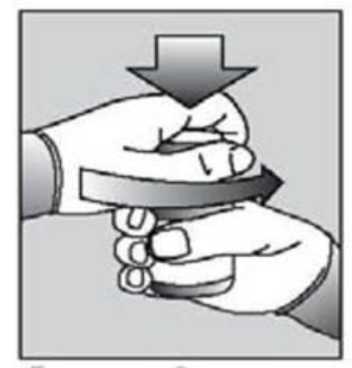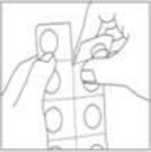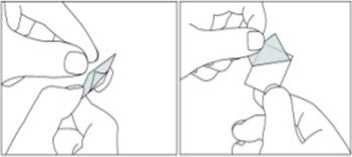Codeine/Paracetamol 30Mg/500Mg Film-Coated Tablets
Codeine/Paracetamol 30mg/500mg film-coated tablets - UK/H/5715/002-003/DC
UK pl
UK/p/004/16/3
Package leaflet: Information for the user
Codeine/Paracetamol 30mg/500mg film-coated tablets
codeine phosphate and paracetamol
Read all of this leaflet carefully before you start taking this medicine because it contains important information for you.
- Keep this leaflet. You may need to read it again
- If you have further questions, ask your doctor or pharmacist
- This medicine has been prescribed for you only. Do not pass it on to others. It may harm them, even if their signs of illness are the same as yours.
- If you get any side effects, talk to your doctor or pharmacist. This includes any possible side effects not listed in this leaflet. See section 4.
What is in this leaflet
1. What Codeine/Paracetamol is and what it is used for
2. What you need to know before you take Codeine/Paracetamol
3. How to take Codeine/Paracetamol
4. Possible side effects
5. How to store Codeine/Paracetamol
6. Contents of the pack and other information
1. What Codeine/Paracetamol is and what it is used for
The name of your medicine is Codeine/Paracetamol 30mg/500mg film-coated tablets. Codeine/Paracetamol 30mg/500mg film-coated tablets contain two different analgesics (painkillers) called paracetamol and codeine (as codeine phosphate hemihydrate). Codeine belongs to a group of medicines called opioid analgesics which act to relieve pain.
Codeine/Paracetamol can be used in children over 12 years of age for the short-term relief of moderate or severe pain that is not relieved by other painkillers such as paracetamol or ibuprofen alone.
2. What you need to know before you take Codeine/Paracetamol Do not take Codeine/Paracetamol:
- if you are allergic to codeine, paracetamol or any of the other ingredients of this medicine (listed in Section 6). Signs of an allergic reaction include a rash and breathing problems. There can also be swelling of the legs, arms, face, throat or tongue
- if you are allergic to soya or peanut
- if you have severe asthma attacks or severe breathing problems
- if you have recently had a head injury
- if you have severe liver problems
- if you have been told by your doctor that you have increased pressure in your head. Signs of this include: headaches, being sick (vomiting) and blurred eyesight
- if you have recently had an operation on your liver, gallbladder or bile duct (biliary tract)
- if you are taking medicine to treat depression called MAOIs (monoamine oxidase inhibitors) or have taken them in the last 2 weeks. MAOIs are medicines such as moclobemide, phenelzine or tranylcypramine (see ‘Other medicines and Codeine/Paracetamol’)
- if you have acute alcoholism
- if you are a breastfeeding woman
- if you know that you metabolise codeine very rapidly into morphine.
Do not take Codeine/Paracetamol for longer than your doctor tells you to.
Do not use this product for pain relief in children and adolescents (0-18 years of age) after removal of their tonsils or adenoids due to obstructive sleep apnoea syndrome.
Warnings and precautions
Talk to your doctor or pharmacist before taking Codeine/Paracetamol:
- if you have severe kidney problems
- if you have liver problems
- if you have problems passing water or prostate problems
- if you have an underactive thyroid gland
- if you have an addiction to opioids
- if you have problems with your adrenal glands
- if you have a bowel problem such as colitis or Crohn’s disease or a blockage of your bowel
- if you are elderly
- if you have anaemia (a reduced number of red blood cells)
- If you are malnourished or dehydrated
- if the person going to take the tablets is under 18 years of age and has breathing problems
Taking codeine regularly for a long time can lead to addiction, which might cause you to feel restless and irritable when you stop taking the tablets
Taking a painkiller for headaches too often or for too long can make them worse
Never take more of Codeine/Paracetamol than recommended. A higher dose does not increase pain relief; instead it can cause serious liver damage. The symptoms of liver damage occur first after a few days. It is therefore very important that you contact your doctor as soon as possible if you have taken more Codeine/Paracetamol than recommended in this leaflet.
Codeine is transformed to morphine in the liver by an enzyme. Morphine is the substance that produces pain relief. Some people have a variation of this enzyme and this can affect people in different ways. In some people, morphine is not produced or produced in very small quantities, and it will not provide enough pain relief. Other people are more likely to get serious side effects because a very high amount of morphine is produced. If you notice any of the following side effects, you must stop taking this medicine and seek immediate medical advice: slow or shallow breathing, confusion, sleepiness, small pupils, feeling or being sick, constipation, lack of appetite.
Children and adolescents
Codeine/Paracetamol should not be taken by children under 12 years of age.
Use in children and adolescents after surgery
Codeine should not be used for pain relief in children and adolescents after removal of their tonsils or adenoids due to Obstructive Sleep Apnoea Syndrome.
Use in children and adolescents with breathing problems
Codeine is not recommended in children or adolescents with breathing problems, since the symptoms of morphine toxicity may be worse in these children.
Other medicines and Codeine/Paracetamol
Tell your doctor or pharmacist if you are taking, have recently taken or might take any other medicines.
This is especially important in the case of:
- Medicines to treat depression
- Medicines which make you drowsy or sleepy (CNS depressants) such as sleeping pills, medicines to treat anxiety or anaesthetics
- Medicines used to thin the blood such as warfarin
- Medicines for irregular heartbeats such as quinidine
- Antibiotics used to treat infections (e.g. chloramphenicol, rifampicin)
- Metoclopramide or domperidone - used to stop you feeling sick (nausea) or being sick (vomiting)
- Cholestyramine - for lowering blood cholesterol levels
- Probenecid - used to treat gout
- The herbal remedy ‘St John Wort’
- Cimetidine - used to treat heartburn and peptic ulcers
- Other painkillers
- Barbiturates (e.g. phenobarbital)
- Medicines to treat epilepsy (e.g. phenytoin, carbamazepine)
- The oral contraceptive pill
While taking Codeine/Paracetamol you should not take any other medicines which contain paracetamol.
This includes some painkillers, cough and cold remedies. It also includes a wide range of other medicines available from your doctor and more widely in shops.
Codeine/Paracetamol with food, drink and alcohol
You should not drink alcohol while you are taking these tablets. This is because alcohol can increase the risk of serious side effects
Pregnancy and breast-feeding
If you are pregnant or breast-feeding, think you may be pregnant or are planning to have a baby, ask your doctor or pharmacist for advice before taking this medicine.
Codeine/Paracetamol should not be used during pregnancy unless advised by your doctor. Regular use during pregnancy may cause withdrawal symptoms in the newborn. If used, you should use the lowest possible dose that reduces your pain and/or your fever and use it for the shortest time possible.
Do not take Codeine/Paracetamol while you are breastfeeding, since it passes into breast milk.
Driving and using machines
You may feel dizzy or sleepy while taking Codeine/Paracetamol. If this happens, do not drive or use any tools or machines.
Codeine/Paracetamol contains lecithin soya
If you are allergic to peanut or soya, do not take this medicine.
3. How to take Codeine/Paracetamol
Always take this medicine exactly as your doctor or pharmacist has told you. Check with your doctor or pharmacist if you are not sure.
• Do not take more than the recommended dose
• This medicine should not be taken for more than 3 days. If the pain does not improve after 3 days, talk to your doctor for advice
Take this medicine by mouth.
Swallow the tablets whole with a drink of water. If necessary, the tablets may be broken in half to make them easier to swallow.
Adults
- The recommended dose of Codeine/Paracetamol is 1 or 2 tablets
- Wait at least 4 hours before taking another dose
- Do not take more than 8 tablets in any 24-hour period
- Elderly people may be prescribed a lower dose
- Patients with kidney problems may require longer intervals between doses
Adolescents over 50kg of body weight aged 16 years and above
- The recommended dose of Codeine/Paracetamol is 1 or 2 tablets
- Wait at least 6 hours before taking another dose
- Do not take more than 8 tablets in any 24-hour period
Children and adolescents 12 to 15 years
- The recommended dose of Codeine/Paracetamol is 1 tablet
- Wait at least 6 hours before taking another dose
- Do not take more than 4 tablets in any 24-hour period
Children under 12 years
Codeine/Paracetamol should not be given to children under 12 years of age, due to the risk of severe breathing problems.
For child resistant bottles only: Instructions for use of child resistant bottles: Push down the lid and turn to open

[For child resistant blister packs only:]
Instructions for use of child resistant blisters:
1. Do not try and push the tablet directly out of the pocket. The tablet cannot be pushed out through the foil. Instead the foil must be peeled back.
2. First, separate one blister cell from the rest of the strip at the perforations

3. Then carefully peel off the backing to open the pocket

4. You can then remove the tablet from the pocket
If you take more Codeine/Paracetamol than you should
- Tell your doctor or go to your nearest hospital casualty department straight away - even if you feel well. This is because too much paracetamol can cause delayed, serious liver damage.
- Remember to take any remaining tablets and the pack with you. This is so the doctor knows what you have taken
If you forget to take Codeine/Paracetamol
If you forget to take a dose at the right time, take it as soon as you remember.
However, if it is almost time for your next dose, skip the missed dose. Do not take a double dose to make up for a forgotten dose. Remember to leave at least 4 hours between doses for adults and 6 hours between doses for children and adolescents.
If you stop taking Codeine/Paracetamol Changing or stopping treatment
Long term usage of Codeine/Paracetamol may lead to tolerance and dependence. If you have taken regular daily doses of Codeine/Paracetamol for a long time, you may experience withdrawal symptoms if you suddenly stop treatment. Contact your doctor for advice on how to stop taking the tablets gradually to avoid withdrawal symptoms.
If you have any further questions on the use of this medicine, ask your doctor, pharmacist or nurse.
4. Possible side effects
Like all medicines, this medicine can cause side effects, although not everybody gets them.
Important side-effects you should know about
- Taking a painkiller for headaches too often or for too long can make them worse.
- Taking codeine regularly for a long time can lead to addiction, which might cause you to feel restless and irritable when you stop the tablets
Stop taking Codeine/Paracetamol and see a doctor or go to a hospital straight away if:
- You have difficulty in breathing or you feel dizzy
- You get swelling of the hands, feet, ankles, face, lips or throat which may cause difficulty in swallowing or breathing. You could also notice an itchy, lumpy rash (hives) or nettle rash (urticaria). This may mean you are having an allergic reaction to Codeine/Paracetamol.
- You get serious skin reactions. Very rare cases have been reported
Talk to your doctor straight away if you notice the following serious side effect:
- Severe stomach pain, which may reach through to your back. This could be a sign of inflammation of the pancreas (pancreatitis). This is a very rare side effect
Other side effects:
Common: may affect up to 1 in 10 people:
Drowsiness, headache, abnormal sweating, feeling sick (nausea), being sick (vomiting), constipation, tiredness.
Uncommon: may affect up to 1 in 100 people:
Dizziness, problems with vision, dryness of the mouth.
Rare: may affect up to 1 in 1,000 people:
You get infections or bruise more easily than usual. This could be because of a blood problem (such as agranulocytosis, neutropenia, pancytopaenia, anaemia or thrombocytopenia). Difficulty sleeping, breathlessness, yellowing of the skin or white of the eyes (symptoms of liver damage), skin rash.
Very Rare: may affect up to 1 in 10,000 people:
Kidney damage has been shown to occur very rarely in patients receiving long term treatment with Codeine/Paracetamol.
Reporting of side effects
If you get any side effects, talk to your doctor or pharmacist. This includes any possible side effects not listed in this leaflet. You can also report side effects directly via the Yellow Card Scheme at: www.mhra.gov.uk/yellowcard. By reporting side effects you can help provide more information on the safety of this medicine.
5. How to store Codeine/Paracetamol
Keep this medicine out of the sight and reach of children.
Do not use this medicine after the expiry date which is stated on the carton or label after ‘EXP’. The expiry date refers to the last day of that month.
This medicine does not require any special storage conditions
For tablet containers only: Shelf-life after first opening: 100 days.
Do not throw away any medicines via wastewater or household waste. Ask your pharmacist how to throw away medicines you no longer use. These measures will help protect the environment.
6. Contents of the pack and other information What Codeine/Paracetamol contains
The active substances are codeine phosphate hemihydrate and paracetamol. Each film-coated tablet contains 30mg of codeine phosphate and 500mg of paracetamol
The other ingredients are povidone (K29/32), magnesium stearate, silica colloidal anhydrous, talc, sodium croscarmellose, copovidone (25.2-30.8), cellulose microcrystalline, hydroxypropylated starch (E1440), mannitol, lecithin soya (E322) and titanium dioxide (E171)
What Codeine/Paracetamol looks like and contents of pack
Codeine/Paracetamol 30mg/500mg film-coated tablets are white, oval, 8.5 x 17mm, biconvex tablets, marked ’5 3’ on one side with a score line.
Pack Sizes:
White PVC/Aluminium blisters or white PVC/Aluminium/PE/paper child resistant blisters: 8, 10, 16, 20, 24, 30, 40, 50 and 100 film-coated tablets
White plastic tablet containers: 50 and 100 film-coated tablets
Not all pack sizes may be marketed.
The Marketing Authorisation Holder and Manufacturer
Marketing Authorisation Holder:
Torrent Pharma (UK) Ltd.
Unit 4, Charlwood Court,
County Oak Way,
Crawley,
West Sussex.
RH11 7XA,
United Kingdom
Manufacturer:
Balkanpharma-Dupnitsa AD 3 Samokovsko Shosse Str.,
Dupnitsa 2600 Bulgaria
Torrent Pharma GmbH Sudwestpark 50 90449 Nurnberg Germany
Heumann Pharma GmbH & Co. Generica KG Sudwestpark 50 90449 Nurnberg Germany